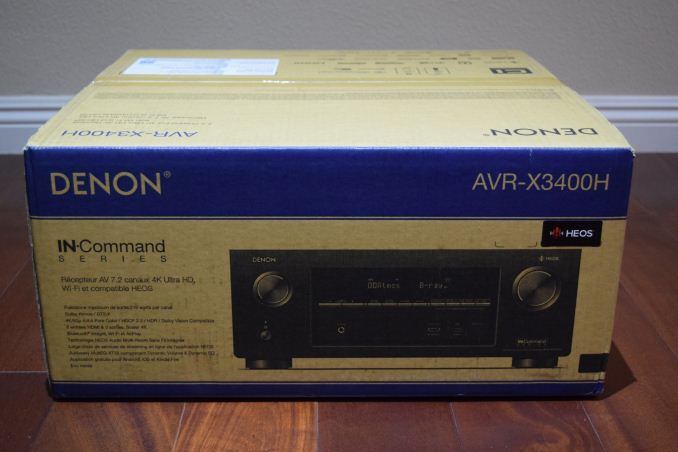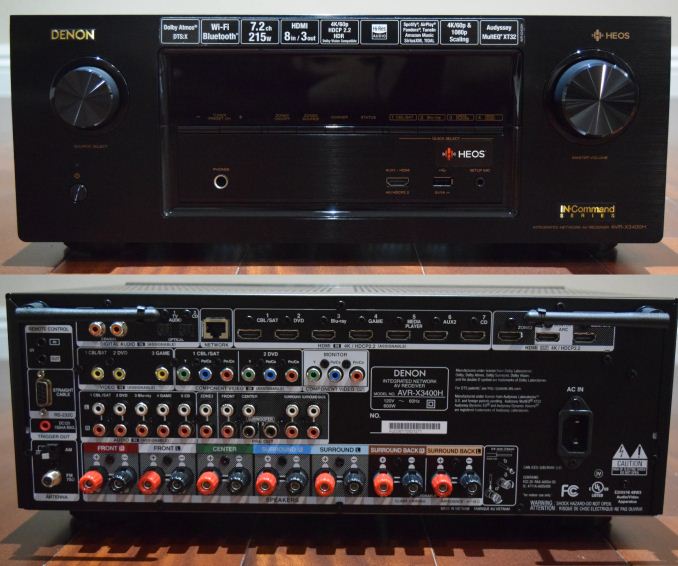A Budget Home Theater & PC Setup: 4K, HDR, UHD Blu-ray, and More
by Ganesh T S on December 26, 2017 8:30 AM ESTThe AVR: Denon X3400H
The choice of AVRs used to be a difficult one to make when support for different HD audio formats was not widespread. Now, the requirements boil down to the AVR being able to support the latest HD audio formats (Dolby Atmos and DTS-X), while matching the capabilities of the display in the chain. The additional features may help sway the purchase decision for consumers.
Budget considerations dictate the number of channels and display zones. We had to migrate from the 7.1 channel Pioneer Elite VSX-32 to a newer receiver capable of handling multiple HDMI 2.0 / HDCP 2.2 inputs with passthrough capabilities for various HDR formats. Based on my budget, I narrowed down the options to one of the models from Denon, Onkyo, Pioneer, and Yamaha. They are all in the same ball park in terms of pricing for a given feature set. We deferred to our friends at Wirecutter, who recommended the Denon AVR S730H.
I had been in touch with Denon regarding HEOS (their whole home audio solution) when the decision to go with a Denon AVR for our HTPC testing setup was taken. Upon discussing our project with them, Denon graciously agreed to sponsor the more advanced AVR X3400H for use in our testing.
The AVR X3400H targets the custom integrator channel. It has a number of additional features such as support for high end DSD audio, 4Kp60 upconversion for analog sources, multi-zone video outputs, higher power output, and support for eARC (Enhanced Audio Return Channel) to justify its higher price over the S730H. The presence of eARC makes it a bit more future-proof, as it allows for HD audio (including the new ones like Dolby Atmos and DTS-X) from the display sink to be returned to the AVR for decode and playback.
In the course of our testing, we found that the AVR received frequent firmware updates to add new features such as HLG passthrough. These point to a well-supported product. Even though the web control feature present in the previous generation Denon AVRs was missed, the Denon AVR Android app made up for it to some extent. None of the issues encountered in the course of the evaluation presented in this piece could be attributed to the Denon AVR X3400H.
If we had to give some suggestions to Denon for the improvement of the AVR X3400H, it would be to bring back the web control feature and shorten the time taken for firmware updates (though there is a facility to enable auto-updates that tries to install the new firmware when the AVR is not being used).
Speakers
Most readers upgrading their HTPC can opt to retain their existing speakers. In fact, I had the Boston Acoustics Horizon Series MCS100MDNT 5.1-channel speaker system from a 2008 purchase, along with a Jamo A306 HCS 5.1 speaker system from my 2011 home theater components upgrade. However, due to the remodel, I had to go in for in-ceiling speakers. I opted for a couple of the Polk Audio RC80i in-ceiling pairs for the rear and surround channel speakers. I bundled them along with ceiling speaker protective covers. The choice of speakers depends on the home theater size and other requirements. Currently, I am using the Jamo A306 speakers for the front, center, and subwoofer, with the Polk Audio RC80i for the other channels.












191 Comments
View All Comments
Azethoth - Monday, January 1, 2018 - link
Why don't you go read an article on _not_ home theater, and regale everyone with how awesome the sound from your shitty TV speakers are. Home theater is simply not for your budget, but don't pretend everyone is living in mom's basement.This article may be out of touch with the 5 of you, but it is not out of touch with the rest of the readers.
Why not go whine in articles about supercars about how they are out of touch with 99.999999% of the planet. Oh noes! I still want to read about them though.
Sivar - Wednesday, January 3, 2018 - link
Most Anandtech readers are tech-savvy, but not tech experts and have normal homes, eyes, ears, and middle-level income (of those in the United States).Talk of an OLED TV or projector tells me that it is you who is out of touch with readers, and it doesn't help that your statement to the author was inappropriately rude.
OLED TVs have an objectively better picture quality, but are much more expensive and the difference is not that noticeable to most people.
Projectors are great (I use one) but are impractical for many (most?) homes because they need light control and, for good pricing, a large flat wall for the screen.
Regarding speakers, if the implication is that there is no noticeable difference between them, then yI suspect you are not at all an enthusiast of home theater. This isn't even a reasonable debate, it just leaves me dumbfounded. True that there is little difference between an extremely fancy speakers (say from Focal or Magico) and a good set of well-designed towers such as those from Ascend or JBL, and indeed the audio industry has a lot of snake oil like expensive cables and any Bose product, but to say that a speaker "works or it doesn't" proves little experience with sound systems, even in the sub-$500 range.
SunnyHours - Wednesday, July 11, 2018 - link
Totally agree with you there!Especially your comment about Cables, Bose (I HATE BOSE!) and mostly the comment that "either a speaker works or it doesn't" that just really surprised me and made me wonder how this person can even entertain the idea of giving tips on a subject you know nothing about...especially on the internet where people will put you on the spot and call you for being an ignorant person and at the same time being a "know it all".
Next thing he will say is that "Vinyls sound like crap and cassettes were a much improved product" LOL.
Dug - Friday, January 5, 2018 - link
He's not out of touch. A good balanced receiver will last much longer in a system than video. Most people upgrade video (tv's, monitors, etc), than they do sound. Projectors don't really fall into the family room scenario either. Usually too much light, sound, maintenance, setup, etc. Plus there's no real 4k hdr affordable projectors out.Bullwinkle-J-Moose - Thursday, December 28, 2017 - link
"So you want a home theater system but don't want to get an AV receiver?"-----------------------------------------------------------------------------------------------------
Why not?
I have a 35 Watt dual-core Sandy Bridge with optical audio output to my Digital EQ (Behringer DEQ24/96) and Balanced XLR to each JBL LSR305 powered monitor
(Behinger AD converters sound like crap but with an optical input, it sounds Fantastical)
Much better than a Denon receiver I do believe
Sure, it's completely Gimped when its running Windows 10 DRM garbage
But, if I want to run 4K on a Gimped System, I can boot to 7 / 8.1 or Spyware Platform 10
I'm running Windows XP right now so I don't need to worry about Bluescreens of Death, malware, or Viruses like I do with Spyware 10
Burns BlueRay Disks fine and can boot to a stock install of XP in 3-4 seconds from a Samsung 850 Pro
Any computer newer than Sandy Bridge is nothing more than a Locked Down Gaming Console with a web browser attached and they make for really piss poor home theater setups
"Personal" Computers died with Sandy Bridge!
You are just renting a JukeBox
Azethoth - Monday, January 1, 2018 - link
I am missing the part where your "fantastical" Behringer DEQ24/96 decodes Dolby Surround.You are failing at Home Theater. There are standards. One of them is surround sound.
Stereo is for listening to old timey music. I am willing to put my Denon in surround stereo up against your stereo thing anytime. I will also pretend that Denon is better, except it would actually be true unlike your imaginings where an optical in somehow makes a difference.
Just so you know, hard science and engineering tells us that an optical in connection means you 100% do not have what this article is about: the more part of 4k blu ray. Atmos does not fit into optical. Hell, 7.1 and 9.1 surround did not fit.
So you and the rest here are just bloviating without saying anything relevant to the topic.
tl;dr If it is beyond your budget, quit whining and read the follow up article next year. Everything will be cheaper and better.
Bullwinkle-J-Moose - Monday, January 1, 2018 - link
"I am missing the part where your "fantastical" Behringer DEQ24/96 decodes Dolby Surround.You are failing at Home Theater. There are standards. One of them is surround sound."
--------------------------------------------------------------------------------------------------------------------
There is no "Standard" to Home Theater!
Surround Sound is one of many so called "Standards"
Your "Budget" demands "Your Standards"
3.1 / 5.1 / 7.1 / 9.1 are simply additions to the 3.0 "Standard" that I created over 30 years ago
They do not Image a "Standard" stereo output as well as mine and yet you claim "They" are the "Standard"
Advertising propaganda has taught you well
Now go forth and spew nonsense
A "Budget" Home Theater can be whatever you want it to be
Racing Stripes and RGB lighting may cost extra
Reflex - Monday, January 1, 2018 - link
I am unclear on how your setup will do positional audio in a home theater setup. For instance, if I play back DD5.1 content, will your setup put the appropriate audio and effects behind a viewer? If I play Dolby Atmos or DTS X content, will it additionally place the appropriate audio above the viewer's head? If so, how are you handling the decode operation for those standards to translate them to your proprietary speaker number and arrangement?Thanks!
Bullwinkle-J-Moose - Tuesday, January 2, 2018 - link
"If I play Dolby Atmos or DTS X content, will it additionally place the appropriate audio above the viewer's head? If so, how are you handling the decode operation for those standards to translate them to your proprietary speaker number and arrangement?"-------------------------------------------------------------------------------
I support my original "Reference Standard" which preceded Atmos and DTS X
I do not support other "Non-Standards" which came later
The only way a "Non-Standard" Home Theater experience can match the "Stereo" Imaging accuracy of my Reference "Standard" is to steal my design
If Dolby or anyone else can claim to match the Imaging accuracy of my Reference Design, then there are really only two possibilities here that I can see
A: They stole my design
or
B: They are Liars
There either ONE Reference, or there is no reference
Choose Now!
Bullwinkle-J-Moose - Tuesday, January 2, 2018 - link
There is either ONE Reference, or there is no reference at all